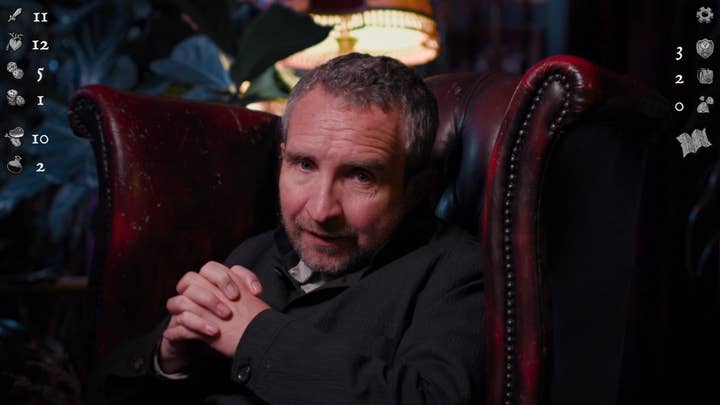Deathtrap Dungeon adaptation aims to demonstrate the true potential of interactive fiction
Branching Narrative's Matt Spall also discusses how the scariest graphics are your imagination
At the start of last year, there was a fair amount of discussion about interactive narrative -- thanks primarily to Bandersnatch, Netflix's choose-your-own-adventure episode of Black Mirror.
Of course, the concept was nothing new (something we explored at length with a variety of developers) but there are still limits to how much players can influence a live-action story without ramping up the production budget by introducing more sets, actors and locations.
UK startup Branching Narrative believes it has a far simpler solution: a man, a chair, and a 35 year-old book.
The book is Deathtrap Dungeon, one of the biggest selling and most fondly remembered entries in the classic Fighting Fantasy series by Ian Livingstone and Steve Jackson. The man is Eddie Marsan, an actor with roles in recent blockbusters such as Fast & Furious spin-off Hobbs & Shaw and Deadpool 2. (The chair is just a chair.)

Branching Narrative's adaptation of this well-loved game-book sees Marsan narrating the story to players, and their choices trigger his delivery of the next relevant section. While this might seem limited in scope, co-founder Matt Spall believes this can deliver much more depth than other games in the space.
"A lot of branching narrative games you see tend to be kind of linear in their delivery," he says. "They let you be free inside that linearity but ultimately there's a beginning and an end, or multiple ends."
The key difference -- and answer to the inevitable question, 'Is this even a game?' -- is that both his adaptation and the original book factor more mechanics into the experience than just simple branching choices. There are the battles, of course, but also luck rolls and skill rolls that may open up other options depending on the player's statistics.
Even the presence of an inventory system, storing items you find earlier in your adventure, elevate Deathtrap Dungeon about interactive narratives centred entirely around binary choices. Opting to pick up certain items will later help you in combat or can be used to solve puzzles and open code doors.
"All you were doing is taking different routes to an outcome. That's not a game"
"Your actions early in the game have significant outcomes later," Spall explains. "In a lot of classic branching narrative books, which didn't have gameplay elements associated with them, all you were doing is taking different routes to an outcome. That's not a game. But here you can find a rope, gems, a dagger -- and that dagger helps you fight a blood-beast later in the game."
If such things are essential to making an interactive narrative more of a game than a branching movie, why even use the live-action elements at all? Why not simply build these mechanics into something more akin to a traditional video game? For Spall, this would negate one of the greatest accomplishments of the original book.
"A lot of branching linear products very much try to dictate the scenario to you, they try to feed you the world like a TV show or film would," he says. "When books have been adapted, [developers] feed you their vision of the book."
But, as players of Deathtrap Dungeon at shows like EGX have expressed, part of the appeal is that the action takes place in their head -- just as it did in the original book.
Spall demonstrates the benefits of this with an early section of the game where -- as Marsan tells us -- you find a bell in a tower. You can walk past or ring it. Choosing the latter triggers the ongoing sound of a large bell, an effect amplified by Marsan raising his voice to narrate the next section. He mentions footsteps approaching, and sure enough, you hear them. A goblin finds you floored by the deafening sounds of the bell, presses his sword into you and runs you through. Nothing has changed on screen, but the scene is all too vivid in your mind.
"The scariest place in the world is the inside of your own head," says Spall. "This is a children's horror book, but there's nothing we can do on the screen that's any more frightening than someone can do in their own head... It's all about feeding the imagination as opposed to dictating what people should think."
Upon their death, readers of the book might simply skip back to before they rang the bell -- perhaps having held a finger between the pages to make the right space -- and continue from there (admit it, we all did it). Branching Narrative has tried to build the same level of accessibility into its game, with a map that builds out with every choice you make, allowing players to jump back to earlier points at will.
"We've tried to be nice to players," he says. "The book is brutal, but there's nothing stopping you going back to one of your fingers. And we're letting people cheat their arse off. At the beginning, you roll to dictate your stamina, but you can keep rolling until you get a number you like. All you're doing then is you're just cheating yourself.
"There's nothing we can do on screen that's more frightening than what's in your own head. It's all about feeding the imagination"
"If you want to be truthful to the game you can be. It's up to you. You've paid for the game, do what you like. We don't want to punish anyone, we don't want them to ever be annoyed about what's going on in the game. I remember someone saying years ago that no game has ever failed because it was too easy. That stuck in my head."
Deathtrap Dungeon is currently in Steam Early Access with plans for a full release, including mobile, in March and console versions to follow. This is the debut game for the studio, and a demonstration of its proprietary engine for interactive narratives (which Spall describes as "a whole bunch of Javascript and an Excel spreadsheet").
Development actually began when a video project for an agency fell through, but that sparked the idea of doing a Jackanory-style presentation of a branching story. Matt and his co-founder Mark Ripley approached Ian Livingstone about using his renowned book as source material. Livingstone agreed and the team got to work... just before Netflix announced Bandersnatch.
"Our first reaction was, 'Oh shit,'" Spall laughs. "But then the second was, 'No, wait, that's a good thing.' Because it's easier to explain now, we can just say, 'Well, have you seen Bandersnatch?'"
Of course, as a team of just three people (plus the videographer hired for filming), it's not possible to create something on the same scale. This also contributed to the decision to have such a minimalist set up.
"There's no reason why at some point in the future we wouldn't go down the route of doing an interactive movie like Bandersnatch or whatever else," say Spall. "But for now, there are advantages to doing it this way.
"Firstly, it's much cheaper to film one person sitting in a room. You can also get it done much more quickly as well. You can technically film more and have a longer story because your commitment to shoot and delivery is linear in relation to the variability of the book."
By comparison, larger productions like the Black Mirror episode, or even Sam Barlow's Telling Lies -- for which the developer had to rent several buildings for filming -- are "limited in their scope, and on the expansiveness of their world."
The hope for Deathtrap Dungeon is not just to appeal to fans of the original Fighting Fantasy books, but to reach newer, younger audiences. While the game will appeal to a particular type of player, it can serve as a testing ground for more original experiences and those based on other properties.
"The reaction we're getting to this means we're hopeful that Ian and Steve Jackson will let us carry on [using Fighting Fantasy]," Spall concludes. "And we're talking to other people, there are other series, there are people writing new ones around public domain stories like Beowulf, Wizard of Oz, Alice in Wonderland. We're going to talk to them. There's so much really well known content that we can draw on -- I'd really like to look at Sherlock Holmes.
"We will court original content, as well. As a business, we'll need to be in a position where we own the IP. This is very much not a one-project thing, and not a 'just other people's books' thing."


